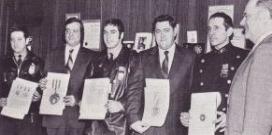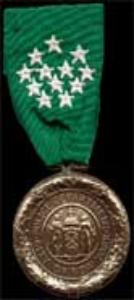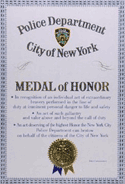
| The history of the Medal of honor is interwoven with the very development of the New York City Police Department. Although the Medal itself has over the years varied in shape and size, those inherent standards of human courage, nobility of action, and valorous conduct have consistently remained steadfast. The current Medal was first awarded at the October 23, 1973, Medal Day Ceremony. It was a unique design which consists of three distinct parts: (1) a bar with the inscription Valor, (2) twelve white stars affixed upon a green ribbon and (3) an eight-pointed and star shaped gold medal whose center depicts the Seal of the City of New York. The Valor inscription symbolizes that quality of extraordinary bravery performed at imminent personal peril, for which the award is presented. Green and white coloration of the ribbon represents the traditional color of the Police Department, while the cluster of twelve white stars are representative of the original twelve police constables who comprised the City's first organized and centrally coordinated police force, dating from the year 1700. Furthermore, the cluster's diamond shaped configuration was inspired by the badge of office worn by policemen during the 1845-1857, and serves as a reminder of that important period of the New York City Police Departments history. As early as 1871, the records of the New York City Police Department reveal the existence of various medals, referred to as a Medal, a Silver Medal, and a Medal of Honor. A review of the Department's annals reveals even another medal, apparently one of similar stature, a gold medal from Congress which was awarded to Roundsman John Delaney of the 21 Precinct who, on December 23, 1879, at risk of his own life, rescued a young boy from drowning. Later promoted to sergeant, John Delaney was to be honorably mentioned in Department records four distinct times for heroic action, ranging from mortal combat with an armed adversary to saving a number of lives by stopping a runaway horse team. Although not specifically referred to as the Medal of honor, apparently the first such award for pure courage in a life and death situation was that given to Patrolman John McDowell, 29 Precinct, for arresting a burglar caught in the act, and being shot while engaged in a gun battle with him on January 12, 1877. This medal, the creation of the famous jeweler Tiffany, was a solid silver and four inches in overall size. The caption Valor appeared on the front and on the back, and is inscribed, Presented to Patrolman John McDowell for Bravery in Pursuance of Resolutions of the Board of Police of New York, January 12, 1877. The first specific mention of a Department Medal of Honor is the honorable mention of Captain John Sanders, 23 Precinct, who on September 22, 1883, rescued several individuals from drowning. In addition to receiving Highly Honorable Mention in the records of the Department, he was awarded the Medal of Honor of the Department for his commendable actions. |
| Medal of Honor |
| Beyond the Line of Duty |
| The New York City Police Department Medal of Honor is the highest award that may be bestowed upon a member of the service. Recipients of this medal are chosen from an already distinct group, those honorably mentioned in Department records for individual acts of extraordinary bravery intelligently performed in the line of duty at imminent and personal danger to life. Specifically, the Department Medal of Honor is awarded for acts of gallantry and valor performed with knowledge of the risk involved, above and beyond the call of duty. The history of the Medal of honor is interwoven with the very development of the New York City Police Department. Although the Medal itself has over the years varied in shape and size, those inherent standards of human courage, nobility of action, and valorous conduct have consistently remained steadfast. The current Medal was first awarded at the October 23, 1973, Medal Day Ceremony. It was a unique design which consists of three distinct parts: (1) a bar with the inscription Valor, (2) twelve white stars affixed upon a green ribbon and (3) an eight-pointed and star shaped gold medal whose center depicts the Seal of the City of New York. The Valor inscription symbolizes that quality of extraordinary bravery performed at imminent personal peril, for which the award is presented. Green and white coloration of the ribbon represents the traditional color of the Police Department, while the cluster of twelve white stars are representative of the original twelve police constables who comprised the City's first organized and centrally coordinated police force, dating from the year 1700. Furthermore, the cluster's diamond shaped configuration was inspired by the badge of office worn by policemen during the 1845-1857, and serves as a reminder of that important period of the New York City Police Departments history. As early as 1871, the records of the New York City Police Department reveal the existence of various medals, referred to as a Medal, a Silver Medal, and a Medal of Honor. A review of the Department's annals reveals even another medal, apparently one of similar stature, a gold medal from Congress which was awarded to Roundsman John Delaney of the 21 Precinct who, on December 23, 1879, at risk of his own life, rescued a young boy from drowning. Later promoted to sergeant, John Delaney was to be honorably mentioned in Department records four distinct times for heroic action, ranging from mortal combat with an armed adversary to saving a number of lives by stopping a runaway horse team. Although not specifically referred to as the Medal of honor, apparently the first such award for pure courage in a life and death situation was that given to Patrolman John McDowell, 29 Precinct, for arresting a burglar caught in the act, and being shot while engaged in a gun battle with him on January 12, 1877. This medal, the creation of the famous jeweler Tiffany, was a solid silver and four inches in overall size. The caption Valor appeared on the front and on the back, and is inscribed, Presented to Patrolman John McDowell for Bravery in Pursuance of Resolutions of the Board of Police of New York, January 12, 1877. The first specific mention of a Department Medal of Honor is the honorable mention of Captain John Sanders, 23 Precinct, who on September 22, 1883, rescued several individuals from drowning. In addition to receiving Highly Honorable Mention in the records of the Department, he was awarded the Medal of Honor of the Department for his commendable actions. On April 20, 1888, the Board of Police Commissioners established the medal as we know it today. The Commissioners ordered the purchase of a die from which the bronze medal was to be cast. On May 18, 1888, a distribution of these medals was made to all members of the Department who, up to then, had received Honorable Mention. After this distribution, the first definite award of the medal was made on January 15, 1889, and in turn, its annual awarding has continued to present day. At the time of formalization there were no other Department medals, and being the only one, it was referred to as the Department's Medal. The New York City Police Department's motto Fidelis ad Mortem (Faithful unto Death) appeared on the surface of the medal.In 1912, a new Medal of Honor was designed. As was its earlier counterpart, this too was created by Tiffany. it consisted of a circular bronze medal bearing the Seal of the City of New York in its center, surrounded by a circular inscription, Police Department, City of New York, within a wreath of oak leaves and acorns. The inscription For Valor was on the reverse side with the name of the recipient and the year awarded within a spray of laurel, all surrounded by a wreath of oak leaves and acorns. This design remained in use until 1973 when the present format was established. The current design is the artistry of the former Police Department historian, the late Detective Alfred J. Young. In 1997, the Medal of Honor was enhanced. This included casting the medal using gold. It is the largest as well as the most prestigious of the Department's medals. The story of the New York City Police Department's Medal of Honor, including the accounts of the brave officers who have been awarded it, is in itself a history of the Department. It is from the actions and sacrifices of these true heroes that went Beyond the Line of Duty. |

Multiple Awards:
Only three members of the New
York City Police Department
have been awarded the Medal of
honor twice:
1) Detective Timothy J. Connell was
awarded his first Medal of Honor in
1922, after he was wounded foiling a
hold up at a cigar store which resulted
in a shoot-out with two armed
perpetrators of which he mortally
wounded one and the second showed
up the next day at a local hospital with
a bullet wound. Detective Connell was
awarded his second Medal of Honor
posthumously in 1926 after he was in
killed in another shootout with four
armed adversaries in 1924.
2) Detective John Cordes was
awarded his first Medal of Honor in
1924 after a shootout in which he was
wounded five times and in 1928 for
another shoot out.
3) Police Officer Robert Bilodeau,
Street Crime Unit, was awarded his first
Medal of Honor for an incident that took
place on April 5, 1979, when while
making an arrest his
throat was slashed, an injury that
required 63 stitches. His second award
was posthumously in 1981 for an
incident that took place on February
12, 1980, when Officer Bilodeau
chased a gunman into an alleyway.
The gunman turned and shot
Officer Bilodeau three times, but before
he died he was able to wound his
assailant.
Note: Both Medals of Honor were
awarded to his wife & son at the
NYPD's 1981 Medal Day award
ceremony.
Only three members of the New
York City Police Department
have been awarded the Medal of
honor twice:
1) Detective Timothy J. Connell was
awarded his first Medal of Honor in
1922, after he was wounded foiling a
hold up at a cigar store which resulted
in a shoot-out with two armed
perpetrators of which he mortally
wounded one and the second showed
up the next day at a local hospital with
a bullet wound. Detective Connell was
awarded his second Medal of Honor
posthumously in 1926 after he was in
killed in another shootout with four
armed adversaries in 1924.
2) Detective John Cordes was
awarded his first Medal of Honor in
1924 after a shootout in which he was
wounded five times and in 1928 for
another shoot out.
3) Police Officer Robert Bilodeau,
Street Crime Unit, was awarded his first
Medal of Honor for an incident that took
place on April 5, 1979, when while
making an arrest his
throat was slashed, an injury that
required 63 stitches. His second award
was posthumously in 1981 for an
incident that took place on February
12, 1980, when Officer Bilodeau
chased a gunman into an alleyway.
The gunman turned and shot
Officer Bilodeau three times, but before
he died he was able to wound his
assailant.
Note: Both Medals of Honor were
awarded to his wife & son at the
NYPD's 1981 Medal Day award
ceremony.
NYPD Medal of Honor facts:
September 11, 2001 resulted in the most
Medal's of Honor being awarded from one
incident with a total of 26 which 23 were
posthumously awarded, (2 of the 26 were
awarded to females).
Only Five females have been awarded
the NYPD Medal of Honor:
1) P.O. Tanya Braithwaite, 1985
2) P.O. Sharon Fields, 1985
3) Det. Kathleen Burke, 1987
4) P.O. Moira Smith, 2001 (Posthumously)
5) P.O. Judith Hernandez, 2003
September 11, 2001 resulted in the most
Medal's of Honor being awarded from one
incident with a total of 26 which 23 were
posthumously awarded, (2 of the 26 were
awarded to females).
Only Five females have been awarded
the NYPD Medal of Honor:
1) P.O. Tanya Braithwaite, 1985
2) P.O. Sharon Fields, 1985
3) Det. Kathleen Burke, 1987
4) P.O. Moira Smith, 2001 (Posthumously)
5) P.O. Judith Hernandez, 2003
Medal of Honor breast bar with
gold oak leaf, (denotes the
second award).
gold oak leaf, (denotes the
second award).
The above MOH was
designed in 1972 by the
late Ptl. Al Young and was
1st awarded in 1973 and
is the Current NYPD
Medal of Honor. (See
photo, 3rd from to the
right.)
designed in 1972 by the
late Ptl. Al Young and was
1st awarded in 1973 and
is the Current NYPD
Medal of Honor. (See
photo, 3rd from to the
right.)


Above is the pre
1973 New York City
Police Department
Medal of Honor.
1973 New York City
Police Department
Medal of Honor.

Above is the citation that is also
awarded along with the actual
Medal of Honor.
awarded along with the actual
Medal of Honor.